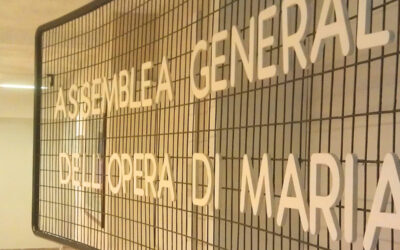‘I belong to the Dominican Sisters of Bethany, a contemplative congregation founded in 1866 by Fr Lataste, a French Dominican. When he was sent to preach in the women’s prison of Cadillac, he had the idea of opening up contemplative life also to those women, once their sentences were over, and he founded a community in which ex-offenders, together with women with no criminal convictions, lived a life of prayer and work together on a completely equal basis and drawing a veil of silence over everyone’s past life.
‘The spirituality of unity and the Word lived and communicated made us realize the value and the relevance of our charism better. Once a week we go to the women’s prison in our city of Turin. Just as in Cadillac, we try to give witness to the hope that comes from God. We meet many women, we offer them the possibility of coming to us when they are released on licence, respecting their legal obligations, for example the need to check in with the police on a daily basis.
‘In the prison we listen to their sorrows, their worries, their pains and their unexpected joys. To extend our charism to the world today, we have started spending time with the people of the night: drug users, the homeless, unscrupulous people on the make both foreign and local, who live in Porta Nuova. We offer them friendship with no strings attached and a chance to meet without demanding that they change. “Are you hungry?” I asked young man from Morocco a little while ago. “Yes, I hunger to be heard, to have relationships, not bread. This is a kind of hunger too.”
‘They know and wait for us at Porta Nuova. As in prison, here too we are spectators of the miracles that sharing out Love makes happen. We could tell many stories. One evening I heard someone calling me. The voice, distorted, came from a pile of blankets. It was a boy obviously going cold turkey. “Tell me, sister, was Jesus Christ tall, blue-eyed and blond?” “I don’t know,” I answered, “I’ve never seen him in person.” He carried on, “He is followed and loved by lots of people.” I responded “He also had problems with the people close to him.” “Physically I look like him, but nobody likes me.” I tried to understand why he was so angry. The tears coursed down his hollow cheeks. “Can I stay for a bit?” I said quietly. Sitting on a station trolley, I listened at length to his story. He spoke like a river in spate. Some years went by. Then, one day, while walking along the street, I hear myself being called. I instantly recognize his blue eyes, which now seem clear, healthy. “I still remember what you said about Jesus Christ! Look! I’m still around!”
‘While I am at Porta Nuova, my community supports me by their adoration of the Blessed Sacrament, so that Jesus may pass through my words and I can recognize him in the faces of the women and men I meet.’
(Sr Silvia, Italy)
Excerpt from Una buona notizia. Gente che crede gente che muove – Città Nuova Editrice, 2012




0 Comments